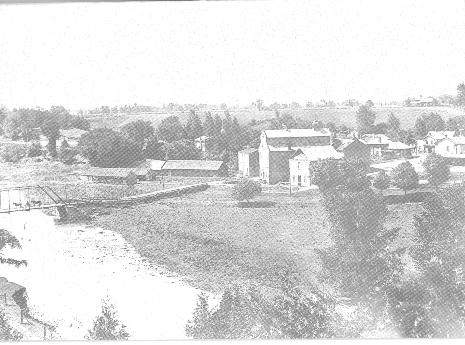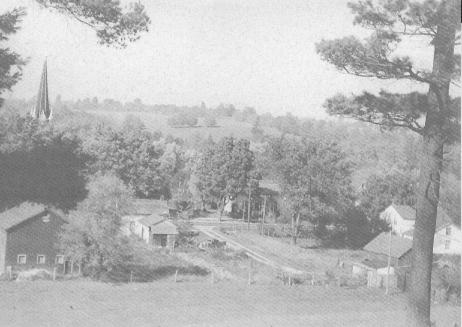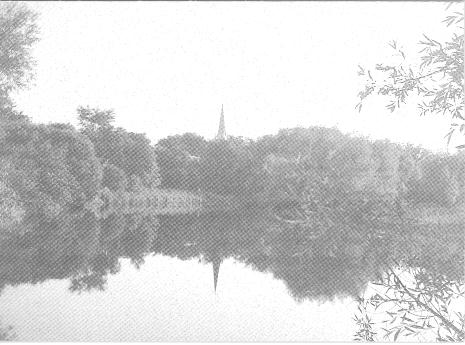
Lucy's Norval: L.M. Montgomery in Halton Hills
Norval's History
Pages
Welcome to Lucy's NorvalLucy Maud MontgomeryNorval's HistoryFriends, Family and NeighboursAround TownKeeping BusySo Long, NorvalReferencesRead More:
More on Norval's HistoryTimeline of Halton Hills History“Norval is in Esquesing Township in the county of Halton. Across the river is Chinguacousy township in Peel County. In childhood days I had to learn all the counties of Ontario off by heart … I had no idea then that “Halton, Peel” would ever mean anything to me but a name. And now I am living in one on the borders of the other” L.M. Montgomery’s journal, February 28, 1926
Norval in the 1920s
By the time Montgomery and her family arrived in Norval, the village had been settled for just over a hundred years and was a thriving community.As a small community, the residents of Norval were tightknit with many events yearlong that everyone would attend, such as garden parties, picnics and plays. The locals of Norval were sociable and often stopped in to visit Montgomery at the Manse. In the summer, residents would swim in the Credit River and in the winter, use it for skating.
Like the rest of Canada, the 1920s was a time of change for Norval as modern inventions swept across the country. Two years prior to Montgomery’s arrival, hydro had arrived in the village and she was happy to have it when she moves to Norval, remarking on how useful it is in her journals. In 1928, an electric stove and a hot- and cold-water system were installed in the Manse, marking the next step towards modernity.
The flour mill in town was an important employer, as well as some of the mills in nearby villages. Montgomery notes in her journal that “there are almost no girls who “work out” and the few who do go to the woollen mills in the Glen” (June 11, 1926), referring to the mills in Glen Williams. Three new bridges were built in Norval during the 1920s. In one of Montgomery’s first walks around Norval upon their arrival in 1926, she notes in her journal that the main street was a “long straggling street” with “a general store, a hardware store, a bank, a butcher’s shop – the usual equipment of the country village.”

Nearby, the town of Georgetown was growing fast and becoming an important neighbour to Norval. Village news was published in the Georgetown Herald. As well, it was quite common for residents of Norval to attend events in Georgetown. Concerts were hosted there often.
Three churches were operating in Norval during this time: Norval Presbyterian Church, where Reverend Ewan Macdonald would take up ministry; St. Paul’s Anglican Church; and Norval Methodist Church, which joined the United Church of Canada in 1925 and became Norval United Church. The churches were places of worship but also important to the social life of the community. Unfortunately, during the 1920s, the Presbyterian and United Churches were in turmoil with each other. Montgomery, being the Presbyterian minister’s wife, often felt hostility from some of the United Church-goers.
The Grand Trunk Railway operated through the area beginning in 1856, but closed the Norval station in 1926. The loss of the station was mourned by the community, as reported by the Georgetown Herald the week of its closure. In 1917, however, the Guelph line of the Toronto Suburban Railway had opened and connected Norval with many of the nearby villages and towns, as well as larger cities like Toronto and Guelph. It operated until 1931, allowing residents like Montgomery to travel to and from Toronto with ease. While living in Norval, Montgomery travelled to downtown Toronto frequently to meet with publishers and to go shopping.

Norval in the 1930s
The 1930s brought about a lot of change to Norval and impacted Montgomery’s life in the community. Although her books continued to support her financially along with Macdonald’s post as Reverend, the Great Depression hit the village hard.Already by January 2, 1930, Montgomery herself was feeling the impact of the beginning of the Depression, writing:
“The century is getting to be quite an old maid.
I had another sleepless night last night, not wholly due to face and ear. I got word yesterday that the Canadian Associate Co., a concern in which I have a heavy investment, has had to pass its semi-annual dividend owing to losses in the October stock panic.” L.M. Montgomery’s journal, January 2, 1930
On January 27, 1930, Norval was struck a terrible blow when the local mill almost burned down. Montgomery reported in her journal the following day that “it is a bad blow to Norval for it was the only industry the small village had and several families got their living in it” (January 28, 1930). While reporting on the incident, the Georgetown Herald noted “twelve or thirteen” families would be affected by the loss, quite a large number given the size of the village.
Investment issues and unemployment continued to climb. Montgomery writes in her journal of gardens dying and wells drying up. The Toronto Suburban Railway ceased operations in 1931, ending Norval’s train connection to Toronto.
The decade was not off to a good start.
Global news of war in Japan and China, and tensions in Europe began to worry Norval residents by 1932. The Georgetown Herald carried news from overseas and Montgomery reported in her journal how often the topic of war appeared in conversations – at church, play practices and picnics.
Despite the hardships of the Great Depression, Norval remained a tightknit community and Montgomery helped in her own way to keep spirits high. In 1932, she writes in her journal, “We are getting up a play for Old Tyme night. But I rather enjoy this. We have a bit of fun at the practices and forget our daily dozen of worries” (December 3, 1932). In addition to plays and concerts, cinema grew in popularity and it became more common for Norval residents like Montgomery to travel to nearby Georgetown to watch films in the theatre there.
In April 1935, Reverend Macdonald and Montgomery said goodbye to Norval as they left the village for retirement in Toronto. On her last night in Norval, Montgomery wrote in her journal:
“Tonight I went down to the [post] office for the evening mail for the last time. It is a prosy little village street but I have always loved walking down it because of the enchanting bits of beauty visible in the distance – lovely hills everywhere and the river and the pines – the beautiful trees around the church” April 24, 1935

